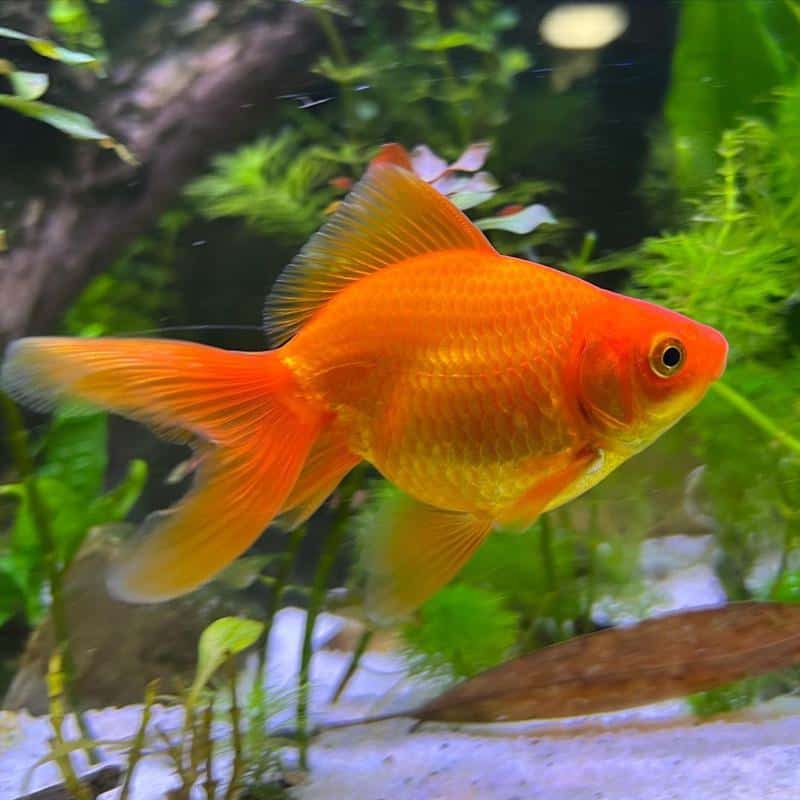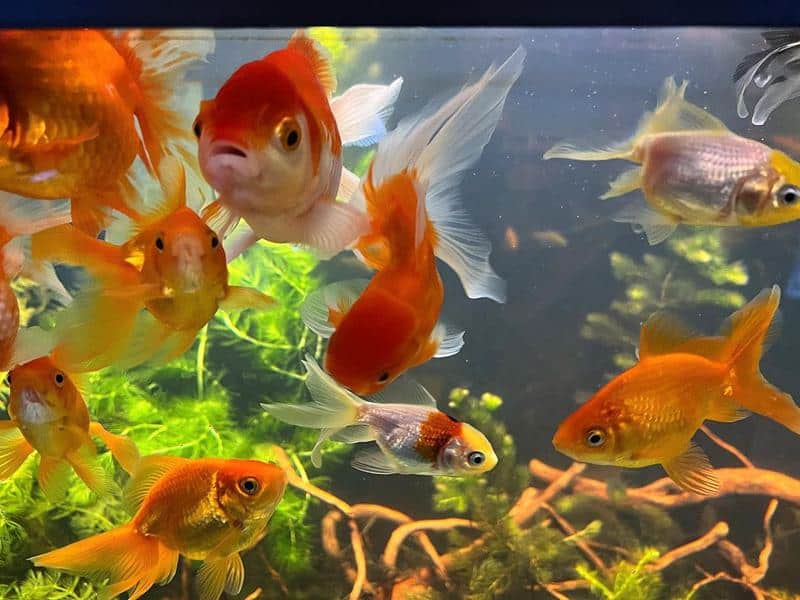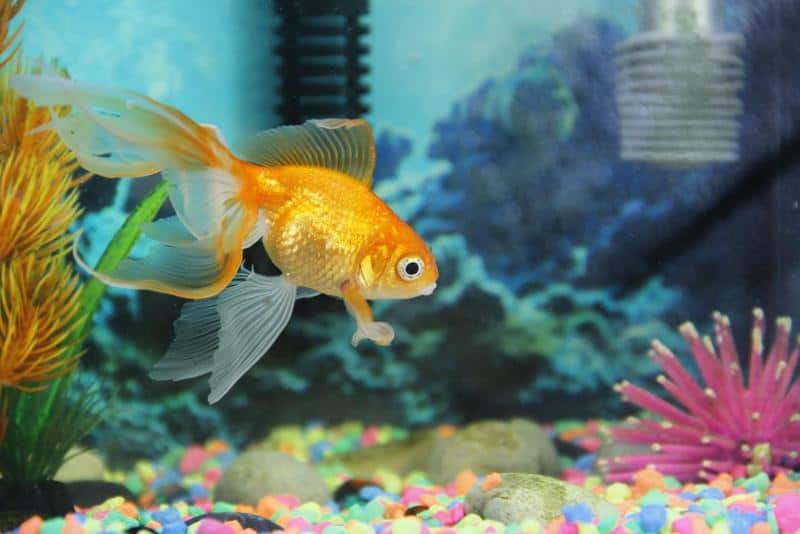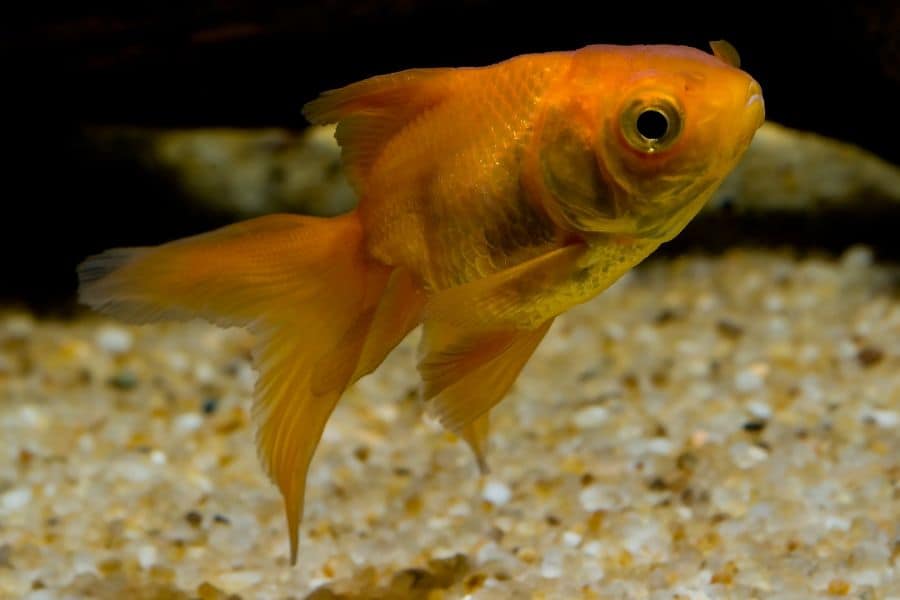Although the Fantail goldfish has fallen out of favor in goldfish beauty pageants, it remains a popular choice among novice hobbyists. Fantails make for a beautiful centerpiece in a community tank due to their bright coloration and flowing tail fins!
Compared to their competitive cousins, these goldfish are less sensitive and demanding. You can get away with keeping two or three of them! In fact, the Fantail goldfish is among the easiest fancy goldfish to care for.
Even so, there are a few care aspects to consider if you want Fantails. In this article, you will learn what those are.
Fantail Goldfish Overview
| Scientific Name | Carassius auratus auratus |
| Size | 6-8 inches |
| Life Expectancy | 7-10 years |
| Temperament | Passive and friendly towards other goldfish |
| Diet | Omnivorous |
| Tank Size | 25 gallons for each fish |
| Tank Temperature | 70-75℉ (21.1 to 23.8℃) |
| Water Hardness | 5-19 dGH |
Natural Habitat and Origin
Decades of selective breeding have yielded a wild variation of goldfish, which includes the Fantail goldfish. However, all goldfish belong to the same species, bearing the same scientific name.
All fancy goldfish are man-made, and each individual species features a handful of different characteristics. For example, Orandas have wens and Ryukins have dorsal humps.
As with other fancy goldfish, the Fantail originated in Asia, particularly in China, where competition for ornamental fish began.
Appearance
The fact that it has a double-tail and a chubby, round body qualifies the Fantail as a fancy goldfish. But in the competitive world of fancy goldfish, aquarists consider the Fantail the most basic.
Fantails are available in reds and oranges. Some fish are solid in color, while others are speckled with white. There are Fantails with metallic bronze scales that reflect light.
Fantail Goldfish Size
A Fantail goldfish can grow 6 to 8 inches long, including its long-flowing tail.
Lifespan
The lifespan of a Fantail goldfish largely depends on how much you’re caring for your fish. Under the best care, your fish can live up to seven or even 10 years.
Temperament
The Fantail goldfish will do fine being alone. Your fish will not need another Fantail to feel safe and happy.
But in my opinion, keeping at least two Fantails or another fancy goldfish would be better to promote activity.
Unlike their slim-bodied cousins, they are not agile swimmers.
Fantail vs. Veiltail Goldfish

People erroneously apply the term “veiltail” to Fantail goldfish, but the Veiltail and Fantail are two different varieties of fancy goldfish. In this section, let us talk about how these two goldfish species differ from each other.
Body Shape
The Fantail and Veiltail goldfish share a couple of traits. Both fancy goldfish have a Ryukin-shaped body without the pronounced dorsal hump. However, the Fantail has a slightly rounder body.
According to the United Kingdom’s Bristol Aquarists’ Society, the breed in question should have a body depth to length ratio of 3:5. This means a five-inch long Fantail should measure three inches from its belly to its back.
Fin Shape and Size
Fantails have longer fins than common goldfish, but they are nowhere near as long and flowing as the fins on Veiltails.
The biggest difference is the shape of their caudal fins. Fantails have forked fin tails, comprising a top and bottom lobe. On the other hand, Veiltails have straight tails with trailing edges.
Fantail Goldfish Tank Setup

In this section, let us talk about what equipment and other items you need to make a cozy home for your new wet pet.
Tank Size
Among goldfish owners, the size of the aquarium can be a source of contention, but I generally advise 25 gallons of water per Fantail, plus 20 gallons for every additional goldfish. The bigger the tank, the better.
Plants and Decorations
Having Fantails or any goldfish, in general, means you can’t have small plants that haven’t rooted deeply. Otherwise, these little buggers will destroy and scatter the plants all over the place.
For a truly beautiful tank, use smooth stones and ceramic aquarium pots for holding plants, such as:
- Anubias (Anubias barteri, Anubias coffeefolia, and Anubias congensis)
- Windelove (Microsorum pteropus)
- African fern (Bolbitis heudelotii)
You can also use artificial plants with soft leaves. Avoid ornaments with sharp ornaments.
Substrate
Goldfish can uproot plants easily, so some people prefer to keep their goldfish tanks bare and put potted aquatic plants in them instead of planting directly into the substrate. But aesthetically speaking, many people dislike bare-bottom tanks.
Bare bottom tanks also deprive your goldfish of their most important natural activity: foraging. Goldfish forage throughout the day, picking up plant matter and leftover food as they find it.
Between gravel and sand, I would suggest you choose the latter. Both substrates do not offer your plants nutrients, so you will likely have to use root tabs and fertilizers to encourage growth unless you prefer potted plants.
On the bright side, sand’s soft consistency allows plants to establish large root systems. Sand provides your goldfish with a soft surface for foraging and it is small enough not to harm them if they accidentally ingest it.
Equipment
Aside from a freshwater testing kit and miscellaneous cleaning tools, here are some equipment you can never do without.
Aquarium Filter
Aquarium owners know how crucial it is to have a reliable filter, especially if you own fish with massive bioloads.
For a fish that can eat up to four times a day, I recommend you purchase a canister filter.
One great example is the OASE Indoor Aquatics Biomaster Thermo 250. This top-of-the-line filter offers an integrated heater and four-stage filtration, among many others.
The only downside to a canister filter is its hefty price tag, but these bad boys are robust and last an eternity.
Alternatively, you can build a sump filter and use high-quality media to make it almost as effective as a canister filter.
Thermometer and Heater
Of course, you’ll need a thermometer and heater because these fish thrive best in warm water. Regardless of where you live, you need a heater to maintain a consistent temperature and prevent fluctuations.
UV Sterilization Pump
Some might say it is unnecessary to use a UV sterilizer unless you are using powerful lighting. However, I disagree.
A UV sterilizer, like the Aqua UV, benefits any aquarium. Using this device is an excellent way to prevent diseases by eliminating bacteria, free-floating parasites, and viruses. Likewise, it keeps the water from becoming cloudy or green due to algae.
Water Parameters and Maintenance
The water parameters for goldfish always seem always open to debate. What exactly do Fantails need? Let’s get to the bottom of this!
Water Hardness and pH
With the help of an aquarium test kit, keep the dGH between 5 to 19 and the pH between 5 to 8.
Water Temperature
Some sources say that it’s fine to keep goldfish in an unheated tank. If you live in a tropical country where it is sunny almost every day, then maybe your tank won’t need heating, especially if your fish dwells in an outdoor pond.
However, it is wrong to assume that Fantails thrive best in cold temperatures like wild, invasive species of goldfish found in lakes across the United States.
The truth is: fancy goldfish cannot tolerate the same gelid temperatures that common goldfish can.
Fantails will do best in warm water from 70 to 75 degrees Fahrenheit (21.1 to 23.8℃). Warm water also increases the metabolism of these fish. Some fishkeepers even feel their Fantails are happiest in water as warm as 80 degrees Fahrenheit (26.6 ℃).
I think people in the West have forgotten that fancy goldfish originated and have been developed in Asia for goldfish beauty pageants. In their homeland, fancy goldfish live in warm waters to enhance their coloration.
Water Changes
Compared to Orandas, Ranchus, and Ryukins, the Fantail goldfish is less demanding in terms of maintenance.
Provided that you have an efficient filter, a water change of 10 percent on weekdays and a 30 percent water change every Saturday will suffice.
It is advisable to use a water conditioner after each water change. In one easy dose, it will effectively render tap water safe by neutralizing chlorine and chloramines, as well as partially eliminate certain metals, like copper and iron.
On Saturdays, I suggest you use Fritz Aquatics Nitrifying Bacteria and let it cycle the next day. Despite the addition of beneficial bacteria, daily water change remains mandatory because the bacteria will eventually die.
Fantail Goldfish Diet
While flake foods are fine, I do not recommend them as a staple food. Flakes may not cause immediate health effects, but it increases the risk of swim bladder disease in goldfish.
Here are some fantastic recommendations for Fantail goldfish:
- Hikari Saki Premium-Grade Fancy Goldfish Food
- Aqueon Sinking Shrimp Pellets
- Aqueon Goldfish Slow-Sinking Granules
- Tetra Goldfish Variety Pellets
Once in a while, feed your fish with steamed eggs. You should also add fiber to your fish’s diet, such as:
- Zucchini slices
- Chopped peas
- Carrot slices
- Lettuce
- Spinach
Once in a while, spice things up a bit by adding freeze-dried krill and bloodworms to their diet.
Related: What Do Goldfish Eat?
How Many Times Should I Feed My Fantail Goldfish?
These water piggies are ravenous! Fantail goldfish eat four to five times a day.
As with other goldfish, the Fantail does not have a real stomach. Different parts of its intestine are responsible for the job that a stomach usually would.
This explains their greedy appetite.
Best Tankmates for Fantail Goldfish

While Fantails can survive alone, they act gregarious towards other Fantails and other fancy goldfish varieties. Fantails can live with Lionheads, Orandas, Pearlscales, Ranchus, Ryukins, Veiltails, and other slow-moving goldfish.
Can you add a Fantail goldfish to a tropical aquarium? Definitely! Fantail goldfish make a brilliant addition to a community tank, as these water piggies just mind their business.
Here are some guidelines to help you narrow down your options:
- Avoid spiny fish
- Stay away from fin nippers
- Never include fish with aggressive tendencies
- Avoid fast-swimming common goldfish that could outcompete your fancy goldfish when it comes to food
Actually, there are many species that can live with Fantails, including playful danios, placid platies, mellow loaches, and, surprisingly, Angelfish! Just make sure to keep those ground rules in mind.
Equally important, the key to a harmonious community is to ensure the tank allows each fish to swim and explore and at the same time, have enough space for them to rest.
Breeding
Fantail goldfish are easy to breed if you have planned far enough in advance.
How Can You Tell a Male and Female Fantail Goldfish?
As with other goldfish, the easiest way to sex Fantails is through checking their genital papilla. Females have rounder protruding papillae, while males have less prominent papillae.
How Old Do Fantail Goldfish Have to Be to Breed?
Fantail goldfish are already reproductive once they reach five months, although it would be best to wait until a year to breed your fish.
Females will look plumper than usual, as they are holding eggs. As for the males, white tubercles will appear on their undersides to indicate their readiness and viability to spawn.
How Do I Set up A Fantail Goldfish Breeding Tank?
You can use the same tank you’ll be using for rearing fry, as long as it doesn’t exceed 10 gallons. If you have a five-gallon tank, the better. Otherwise, breed your Fantails in a small shallow basin.
A small tank allows the female to bond fast with her mate. Likewise, you will want to limit the space to avoid exhausting your female during courtship.
Next, throw in some Cabomba (Cabomba caroliniana) or Hornwort (Ceratophyllum demersum) to make a nest. You can also use artificial breeding grass.
Take note; the tank water should be sitting for three days before you introduce your fish.
You will also need a small airstone. With the help of an airstone, the sperm will travel along the ripples and reach the eggs.
Things You’ll Need:
- A small tank
- Floating plants or artificial breeding grass
- Water conditioned for at least 3 days
- Heater and thermometer
- Airstone
What Is the Easiest Way to Breed a Fantail Goldfish?
Fantail goldfish will breed successfully without your intervention, granted that you have conditioned your fish for weeks.
Males will court females spontaneously if you keep the temperature on the highest end of the recommended range.
Prepare the tank and make sure the water is warm and toasty before adding your fish.
Here’s a tip; add the female to the breeding tank a day ahead of the male. Then leave the pair alone for a day or two for them to do their thing.
While waiting, prepare the new tank water. Treat it with methylene blue and let it sit for at least three days. Methylene blue will prevent fungal growth in fish eggs and fry.
As soon as the male stops chasing the female, you’ll need to take them out of the breeding tank. Otherwise, the parents will gobble up the eggs.
Perform a 100% water change 24 hours after you’ve taken your fish out. Hundreds of eggs will adhere to the grass and tank walls, so there’s no need to worry.
Should I Change the Water in The Fry Tank?
Yes! It is absolutely necessary to make a 20 percent water change every two weeks after the eggs have hatched.
Moreover, don’t forget to use a sponge filter for your fry tank.
What Is the Best Food to Feed Goldfish Fry?
Feed newly hatched fry with daphnia for 10 to 14 days. Baby brine shrimp are even better if your budget allows it.
As long as possible, you’ll want to feed these young fish live foods to ensure their development. A protein-rich diet is a big factor in fry growth.
Alternatively, you can give them homemade steamed eggs mixed with spirulina powder.
All you need is 1 part egg mixed with 1 part water and a teaspoon of spirulina powder. Steam the egg mixture on high heat for two minutes for a runny texture.
Health Risks

Next to swim bladder disease, the most common problem in Fantail goldfish is fin rot. Several factors cause fin rot, and these include:
- poor water quality
- exposure to contagious diseases carried by other fish
- mishandling or injuries
- nipping and bullying behaviors from incompatible tank mates
If a ripped fin leads to fin rot, aquarium antibiotics are necessary. Pet shops sell these medications over the counter. Follow the manufacturer’s instructions carefully.
Tonic salt may also treat fin rot. A dosage of 1 tablespoon per gallon of tank water can discourage fin rot without hurting your fish.
Moreover, Fantail goldfish are just as susceptible to fungal and bacterial infections as other freshwater species. But if you take preventive measures and stay consistent with aquarium maintenance, your efforts will go a long way in mitigating fatal illnesses.
Read More:
Wrapping Up
Many people tend to forget that Fantail goldfish are man-made. You cannot find these fancy goldfish in the wild, as they simply cannot survive such a harsh environment for extended periods.
Therefore, it is wrong to care for them as you would a common goldfish. I hope this article has answered most — if not all — of your questions.
Fantails are a joy to have and they will surely brighten up your tank! Compared to other fancy goldfish, they are a breeze to care for.

